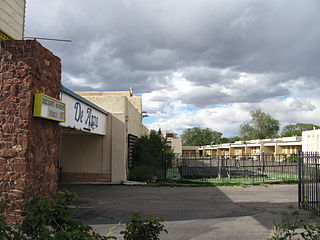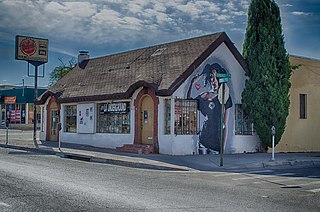
A motel or motor lodge is a hotel designed for motorists and usually has a parking area for motor vehicles. Entering dictionaries after World War II, the word motel, coined as a portmanteau contraction of "motor hotel", originates from the Milestone Mo-Tel of San Luis Obispo, California, which was built in 1925. The term referred initially to a type of hotel consisting of a single building of connected rooms whose doors faced a parking lot and in some circumstances, a common area or a series of small cabins with common parking. Motels are often individually owned, though motel chains do exist.
U.S. Route 66 or U.S. Highway 66, also known as the Will Rogers Highway, the Main Street of America or the Mother Road, was one of the original highways in the U.S. Highway System. US 66 was established on November 11, 1926, with road signs erected the following year. The highway, which became one of the most famous roads in the United States, originally ran from Chicago, Illinois, through Missouri, Kansas, Oklahoma, Texas, New Mexico, and Arizona before ending in Santa Monica in Los Angeles County, California, covering a total of 2,448 miles (3,940 km). It was recognized in popular culture by both the hit song "(Get Your Kicks on) Route 66" and the Route 66 television series, which aired on CBS from 1960 to 1964. In John Steinbeck's classic American novel, The Grapes of Wrath (1939), the road "Highway 66" symbolized escape and loss.

Jones Motor Company is a historic U.S. Route 66-era building in Albuquerque, New Mexico. Built in 1939, on Central Avenue in the Nob Hill neighborhood of Albuquerque, the building originally housed Ralph Jones' service station and Ford Motor Company car dealership. It was designed by Tom Danahy in the Streamline Moderne style, with curved garage bays surmounted by a central stepped tower.

U.S. Route 66 in the state of Texas extended across the Texas Panhandle from its designation in 1926 to its decommissioning in 1985.

The historic U.S. Route 66 ran east–west across the central part of the state of New Mexico, along the path now taken by Interstate 40 (I-40). However, until 1937, it took a longer route via Los Lunas, Albuquerque, and Santa Fe, now roughly New Mexico State Road 6 (NM 6), I-25, and US 84. Large portions of the old road parallel to I-40 have been designated NM 117, NM 118, NM 122, NM 124, NM 333, three separate loops of I-40 Business, and state-maintained frontage roads.

The Wigwam Motels, also known as the "Wigwam Villages," is a motel chain in the United States built during the 1930s and 1940s. The rooms are built in the form of tipis, mistakenly referred to as wigwams. It originally had seven different locations: two locations in Kentucky and one each in Alabama, Florida, Arizona, Louisiana, and California.

The Aztec Motel, also known as the Aztec Auto Court or Aztec Lodge, was a historic motel located on former U.S. Route 66 in the Upper Nob Hill neighborhood of Albuquerque, New Mexico, United States. Until its demolition in 2011 it was the oldest continuously-operating Route 66 motel in New Mexico and "one of the five most important motels left" in Albuquerque.

The Boots Motel, a historic U.S. Route 66 motor hotel in Carthage, Missouri, opened in 1939 as the Boots Court at 107 S. Garrison Avenue.

Castle Apartments was a historic apartment building in Albuquerque, New Mexico, United States, which was destroyed by fire in 2009. It was located on the southeast corner of 15th Street and Central Avenue, roughly halfway between Downtown and Old Town, and took its name from the Huning Castle mansion, which originally stood on the other side of 15th Street.

The De Anza Motor Lodge was a historic motel located on former U.S. Route 66 in the Upper Nob Hill neighborhood of Albuquerque, New Mexico. It was built in 1939 by Charles G. Wallace, a local trader of Zuni art and pottery, who remained the owner until 1983. Wallace decorated the motel with a variety of Native American art, including a series of murals by Zuni artist Tony Edaakie in a basement room.

Nob Hill Business Center is a historic shopping center in Albuquerque, New Mexico. Built in 1946–7, it was the first modern suburban shopping center in New Mexico, and its construction marked a shift away from pedestrian-oriented development in Albuquerque in favor of decentralized, auto-oriented sprawl. Located on Central Avenue at Carlisle Boulevard, the building is the focal point of the Nob Hill district.

The Blue Swallow Court in Tucumcari, New Mexico, United States, is a 12-unit L-shaped motel listed on the National Register of Historic Places in New Mexico as a part of historic U.S. Route 66. Original architectural features included a façade with pink stucco walls decorated with shell designs and a stepped parapet, on-site office and manager's residence and garages located between the sleeping units for travelers to park their motorcars.

Nob Hill is a neighborhood in Albuquerque, New Mexico, consisting of a commercial district along Central Avenue and surrounding residential areas. Located just east of the University of New Mexico, the neighborhood was developed between about 1925 and 1950 and has since become a popular tourist and shopping destination. Known for its eclectic mix of mostly locally owned businesses, Nob Hill has been described as "the heart of Albuquerque's Route 66 culture and also its hippest, funkiest retail and entertainment district". The neighborhood is named after Nob Hill in San Francisco.

The Coral Court Motel was a 1941 U.S. Route 66 motel constructed in Marlborough, Missouri and designated on the National Register of Historic Places in St. Louis County in 1989 as a valuable example of the art deco and streamline moderne architectural styles. It expanded to 77 rooms in the heyday of automobile tourism on US 66, only to decline after the highway was bypassed by Interstate 44 in the 1970s and close its doors forever in 1993. Despite strong local efforts advocating historic preservation, it was demolished in 1995 for a suburban housing development.

The Cactus Motor Lodge, now known as the Cactus RV Park, is a motel located along historic U.S. Route 66 in Tucumcari, New Mexico. I.E. and Edna Perry built the lodge in 1941. The motel included three wings of units forming a "U" shape and an office, the latter of which was a dance hall when the motel opened. In 1952, Norm Wegner purchased the motel; Wegner added an artificial stone exterior to the buildings and converted the dance hall to an office. After Route 66 was decommissioned, the motel lost much of its business, and by the 1990s it became an RV park; the motel units are currently unused. The motel's neon sign was restored in 2008. In October 2018, the sign was sold and removed to be relocated to an Albuquerque neon-sign park. Many other items have been sold off as the current owners negotiate to sell the property itself to O'Reilly Auto Parts.

The West Winds Motel is a historic motel located on old U.S. Route 66 in Erick, Oklahoma. The motel opened in the mid-1940s to serve travelers on Route 66; at the time, tourism drove Erick's economy, and the motel was one of several in the city. The motel had a typical motor court layout with two lodging buildings and an office forming a "U" shape around a central courtyard. The lodging buildings have a Mission Revival design with stucco walls and red metal roofs designed to resemble tile. The motel units have individual garage spaces in front of their entrances, a style which was common in the 1930s and 1940s but fell out of favor in later years.

The El Vado Auto Court is a historic motel in Albuquerque, New Mexico, located along former U.S. Route 66. Built in 1937, it operated until 2005 and reopened in 2018 after renovations. The motel was listed on the New Mexico State Register of Cultural Properties and National Register of Historic Places in 1993, and was also designated an Albuquerque city landmark in 2008.

Nob Hill Motel, formerly the Modern Auto Court, at 3712 Central Ave. SE. in Albuquerque, New Mexico, was built in 1937. It was listed on the National Register of Historic Places in 1993. The listing included four contributing buildings.

The Cottage Bakery is a historic building on Central Avenue in Albuquerque, New Mexico. It was built in 1937 by a local bakery, the Cottage Pure Food Shoppe, and is significant as a relatively unaltered 1930s food-vending establishment, as well as for its use of roadside novelty architecture to attract customers. The front of the building was constructed in the form of a thatched cottage, which was intended to evoke "a bucolic purity that clients would associate with dairy and bakery products". It was listed on the New Mexico State Register of Cultural Properties and the National Register of Historic Places in 1993.




















